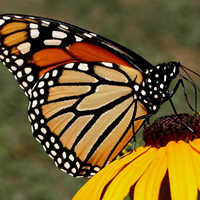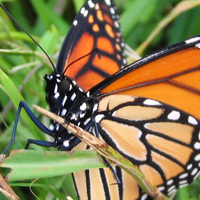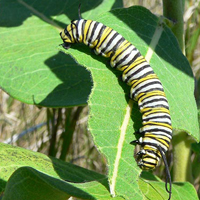Monarch
Scientific name: Danaus plexippus




Cover photos credit: Rick Stankiewicz (left), Larry Watkins (middle-left), John Averill (middle-right), and Alan Dextrase (right)
Status
Special Concern
“Special Concern” means the species lives in the wild in Ontario, is not endangered or threatened, but may become threatened or endangered due to a combination of biological characteristics and identified threats.
Date added to the Species at Risk in Ontario List
The Monarch was already assessed as a species of special concern when the Endangered Species Act took effect in 2008.
Read the most recent assessment report (PDF)
What it looks like
The Monarch is a showy orange and black butterfly with small white spots. These butterflies are relatively large with a wingspan reaching 93-105 millimetres. The Monarch’s caterpillar is easily recognized: It has black, white and yellow stripes and can be found feeding on milkweed plants. After their feeding and growth stage, the Monarch caterpillar moults into a striking jade-coloured chrysalis with golden spots.
Where it lives
Throughout their life cycle, Monarchs use three different types of habitat. Only the caterpillars feed on milkweed plants and are confined to meadows and open areas where milkweed grows. Adult butterflies can be found in more diverse habitats where they feed on nectar from a variety of wildflowers. Monarchs spend the winter in Oyamel Fir forests found in central Mexico.
Where it’s been found in Ontario
The Monarch’s range extends from Central America to southern Canada. In Canada, Monarchs are most abundant in southern Ontario and Quebec where milkweed plants and breeding habitat are widespread. During late summer and fall, Monarchs from Ontario migrate to central Mexico where they spend the winter months. During migration, groups of Monarchs numbering in the thousands can be seen along the north shores of Lake Ontario and Lake Erie.
What threatens it
The largest threat to Ontario Monarchs is habitat loss and fragmentation at overwintering sites in central Mexico where forests are being logged and converted into agricultural fields and pastures. Widespread pesticide and herbicide use throughout the Monarch’s range may also limit recovery.
Action we are taking
Special concern species do not receive species or habitat protection.
What you can do
Report a sighting
- Report a sighting of an endangered animal or plant to the Natural Heritage Information Centre. Photographs with specific locations or mapping coordinates are always helpful.
- Populations of many insects that pollinate plants are declining around the world; for information on how you can easily give insect pollinators a helping hand visit: Seeds of Diversity
- Journey North is an online project that tracks the migration of Monarchs; classrooms can participate by sharing their sightings.
Volunteer
Volunteer with your local nature club or provincial park to participate in surveys or stewardship work focused on species at risk.
Be a good steward
- Private land owners have a very important role to play in species recovery; you may be eligible for stewardship programs that support the protection and recovery of species at risk and their habitats
- Pesticides can be harmful to Monarch habitat; to learn how to keep your lawn and garden healthy and green without using pesticides visit this page.
Report illegal activity
Report any illegal activity related to plants and wildlife to
Quick facts
- In the fall, Monarchs travel up to 3,000 kilometres between breeding grounds in eastern North America and overwintering sites in central Mexico; some Monarchs can travel an astonishing 80 kilometres in a single day.
- Although most adult Monarchs only live for about four to five weeks, individuals that metamorphose into butterflies during autumn can live for seven to eight months; it is this generation that migrates south for the Canadian winter.
- The Monarchs that travel from eastern North America to Mexico are not the same ones that return the following spring; as they leave the winter sites in Mexico, these older butterflies lay eggs in the southern United States; the descendants of that generation are the ones that fly north to Canada.
- There is a toxin in milkweed plants that Monarch caterpillars are able to store in their bodies as they feed; the toxin stays in their system and makes the adults poisonous to bird predators.
- Another species of butterfly, the Viceroy, looks very similar to the Monarch; the Viceroy doesn’t eat milkweed, but most predators avoid the Viceroy, since it is easily confused with the toxic Monarch; in fact, there is evidence that the Viceroy may also be toxic because of a substance their caterpillars eat from willow leaves; some predators may avoid the Monarch because it looks too much like a toxic Viceroy.